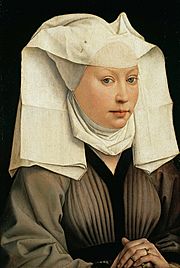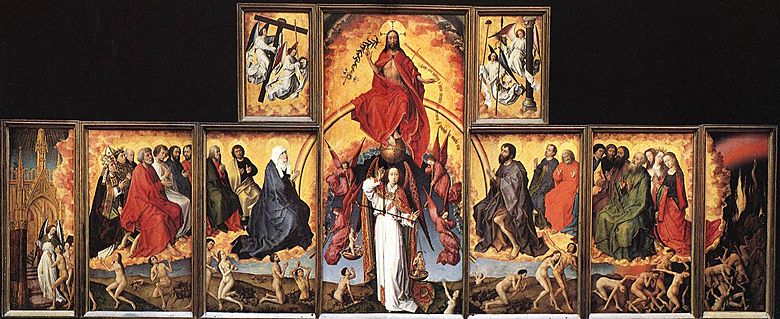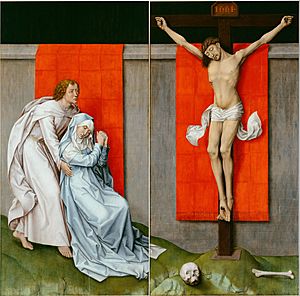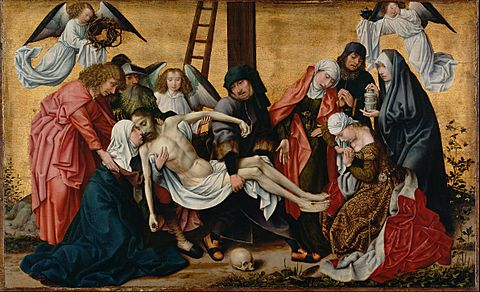Rogier van der Weyden facts for kids
Rogier van der Weyden (born around 1399 or 1400, died June 18, 1464) was a very important painter from the Netherlands. He was known for his religious paintings, like those on altars, and for portraits of people.
During his life, Rogier was very successful. His paintings were sent to countries like Italy and Spain. Important people, including Philip the Good (a powerful duke), asked him to paint for them. For a while, he was even more famous than another great painter, Jan van Eyck. However, after the 17th century, people started to forget about him. Luckily, his amazing art was rediscovered over the next 200 years. Today, he is seen as one of the three greatest early Flemish artists, along with Robert Campin and Jan van Eyck. Many people consider him the most influential Northern painter of the 15th century.
We don't know many details about Rogier van der Weyden's life. Most of what we know comes from old city records that are not complete. But experts agree that many paintings we see today were made by him. They can tell this from his unique style.
Rogier often painted people he saw in real life. He was very good at noticing small details. But he also liked to make people look even better in his paintings. He often made their faces look perfect, especially in his large religious artworks called triptychs. His paintings use rich, warm colors and show a lot of feeling. He was known for making his figures look very natural and emotional. His portraits usually show people from the waist up and slightly turned to the side. He used many different colors and shades, making each part of his paintings unique.
Contents
Early Life and Art Training
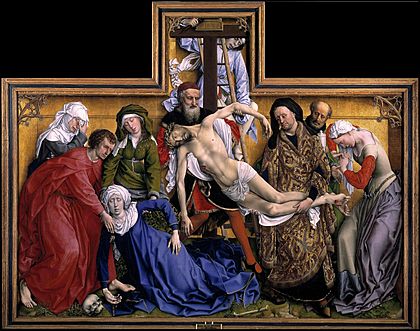
Many old records about Rogier van der Weyden's life were lost in fires, so we don't have all the facts. Rogier was born in Tournai, which is now in Belgium, in 1399 or 1400. His parents were Henri de le Pasture and Agnes de Watrélos. His father was a knife maker.
In 1426, Rogier married Elisabeth. Her father was a shoemaker in Brussels. Rogier and Elisabeth had four children. Their first son, Cornelius, born in 1427, became a monk. Their daughter, Margaretha, was born in 1432. By 1435, the family moved to Brussels. Their two younger sons, Pieter (born 1437) and Jan (born 1438), were born there. Jan later became a painter, and Pieter became a goldsmith.
From 1436, Rogier became the official 'painter to the town of Brussels'. This was a very important job because Brussels was a major city for the Dukes of Burgundy. When he moved to Brussels, Rogier started using the Flemish version of his name: "Rogier van der Weyden."
We don't know much about how Rogier learned to paint. Some old records from Tournai were destroyed in World War II. However, some parts were copied before that. On November 17, 1426, the city of Tournai gave wine to a "Maistre Rogier de le Pasture." This suggests he was already a respected artist.
But then, in March 1427, records show a "Rogelet de le Pasture" joined the workshop of Robert Campin. He joined with another artist named Jacques Daret. This might seem strange since he was already a master. It's possible that joining the workshop was a legal step. Or maybe he had an academic degree before he became a painter. The detailed and smart ideas in his paintings make some people think he was well-educated.
Experts believe Rogier van der Weyden was a student of Robert Campin. This is because the paintings of Jacques Daret (who was Campin's student) and those by Campin and van der Weyden look very similar in style.
Becoming Famous in Brussels
The last time Rogier de la Pasture is mentioned in Tournai records is in October 1435. It says he was "living in Brussels." At the same time, Rogier de Weyden is first mentioned as the official painter of Brussels. This confirms that they are the same person. The job of city painter was created just for Van der Weyden. It meant he had a huge project: to paint four scenes about justice for the "Golden Chamber" of Brussels City Hall.
Rogier became quite wealthy. He owned properties and made investments. He painted portraits of the Dukes of Burgundy and their families, showing he was close to the most powerful people in the Netherlands. Even though he was rich, Rogier also gave a lot of money to the poor. He even helped manage a hospital and charity in Brussels from 1455 to 1457.
The Miraflores Altarpiece was likely ordered by King Juan II of Castile. He gave it to a monastery in 1445.
Some sources say Rogier traveled to Italy in 1449. He might have visited Rome in 1450. This trip would have allowed him to meet Italian artists. However, his time in Italy did not change his painting style. Important Italian families, like the House of Este and the House of Medici, asked him to paint for them. Even the Duke of Burgundy and the future King Louis XI of France helped convince Rogier to take on an apprentice. A court painter from Milan, Zanetto Bugatto, came to Brussels to learn from Rogier.
Rogier's fame grew around the world. In the 1450s and 1460s, famous scholars praised him. They called him "the greatest" and "the most noble" of painters.
Rogier van der Weyden died on June 18, 1464, in Brussels. He was buried in the Cathedral of St. Michael and St. Gudula.
His Artworks
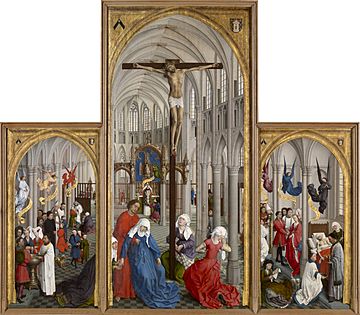
We know of relatively few paintings by Rogier van der Weyden, even though he had a long career. This doesn't mean he didn't paint much, but rather that many of his works might have been lost. Still, his style was very clear, and most experts agree on which paintings are his. Rogier did not paint any self-portraits (pictures of himself). However, some think he might have included himself in one of his "Justice panels."
Many of his most important works were destroyed in the late 1600s. He first appears in historical records in 1427. He studied painting under Robert Campin from 1427 to 1432. Rogier soon became more famous than his teacher and even influenced Campin's later work. After his training, he became a master painter in the Tournai Guild of St Luke. He moved to Brussels in 1435. There, he quickly became known for his amazing technical skills and how he used lines and colors to show emotion.
He finished his masterpiece, Deposition, in 1435. This painting made him one of the most sought-after artists in Northern Europe.
A small part of a painting called The Magdalen Reading in London is considered one of his early masterpieces. Since the 1970s, this painting has been linked to two small heads of Saint Catherine and Saint Joseph in a museum in Lisbon. Experts now believe these three pieces came from a larger altarpiece (a painting behind an altar). This altarpiece showed the "Virgin and Child with Saints." At some point before 1811, this large painting was cut into these three smaller parts.
The lost painting The Justice of Trajan and Herkinbald was very famous. It had four large panels that showed scenes of justice. The City of Brussels ordered these paintings for the "Golden Chamber" of the Brussels Town Hall. The first and third panels were signed by Rogier, and the first was dated 1439. All four were finished before 1450. Sadly, they were destroyed when the French attacked Brussels in 1695. But we know about them from many descriptions, a tapestry copy, and other drawings. The paintings were huge, about 4.5 meters each. They were meant to show examples of justice to the city officials who made decisions in that room. Many famous people, like Albrecht Dürer, praised these paintings before they were destroyed.
In his portraits, Rogier van der Weyden often made the people look better than they might have in real life. He would make their faces softer or more ideal. He often made their eyes larger, their face shapes clearer, and their jaws stronger. Among his most famous portraits are those of Philip the Good, his wife Isabella of Portugal, Duchess of Burgundy, and their son Charles the Bold.
Rogier's Influence on Art
Rogier's strong, detailed, and emotional paintings had a huge impact on art across Europe. His influence reached France, Germany, Italy, and Spain. Art historian Erwin Panofsky noted that Rogier van der Weyden introduced new ways to show religious stories. He painted people who paid for the art taking part in holy events. He also combined half-portraits of the Virgin Mary with portraits of people praying to create two-part paintings called diptychs. He also made the story of Saint Jerome removing a thorn from a lion's paw more popular.
Hans Memling was one of Rogier's most important followers, though we don't know for sure if he was a student. Rogier also greatly influenced the German painter and engraver Martin Schongauer. Schongauer's prints (artworks made by printing) were shared all over Europe in the late 15th century. These prints helped spread Rogier van der Weyden's style even further. Experts say that almost all 15th-century artists were influenced by Rogier van der Weyden's art in some way.
Images for kids
-
Durán Madonna, 1435-38
See also
 In Spanish: Rogier van der Weyden para niños
In Spanish: Rogier van der Weyden para niños



